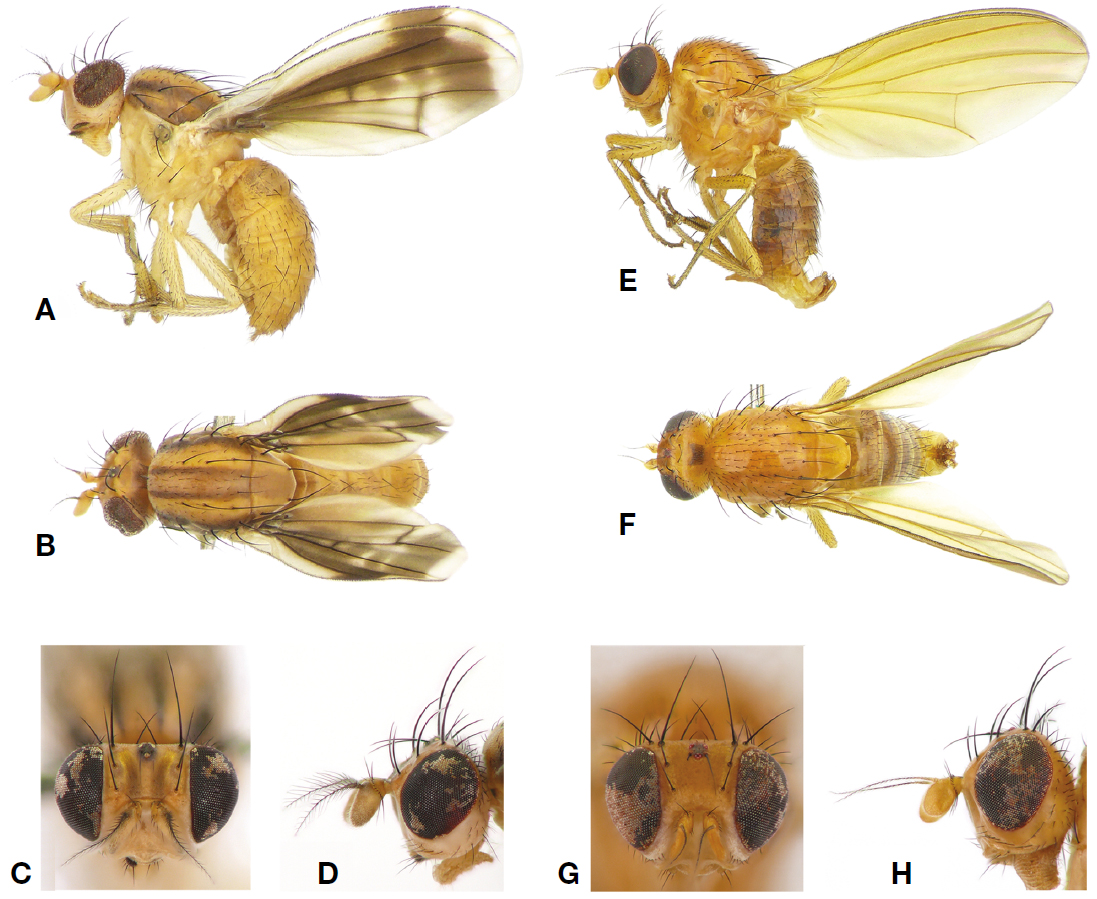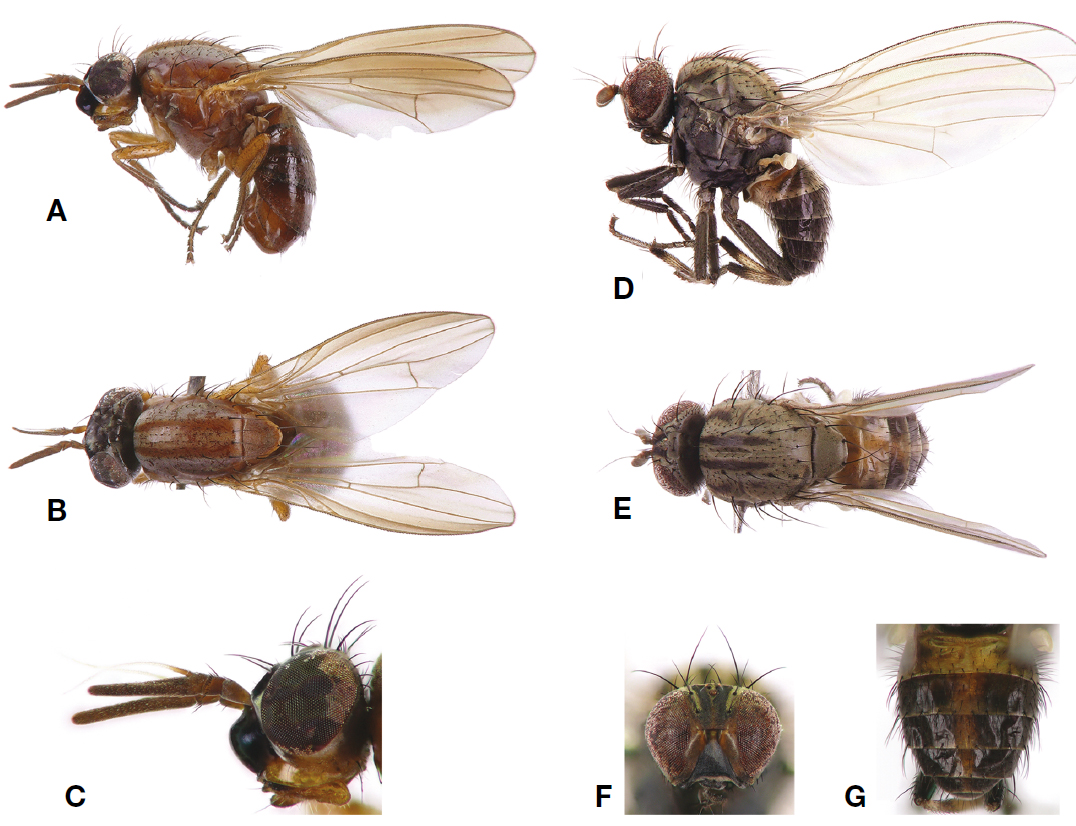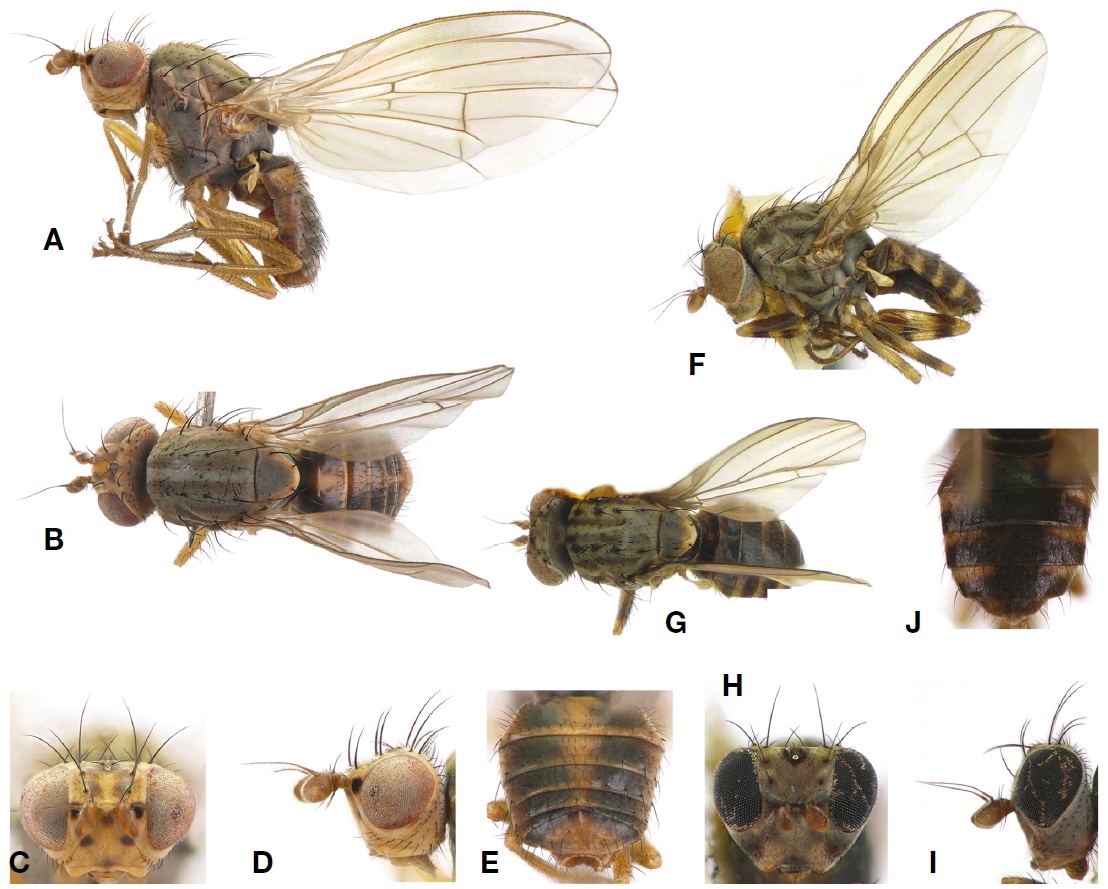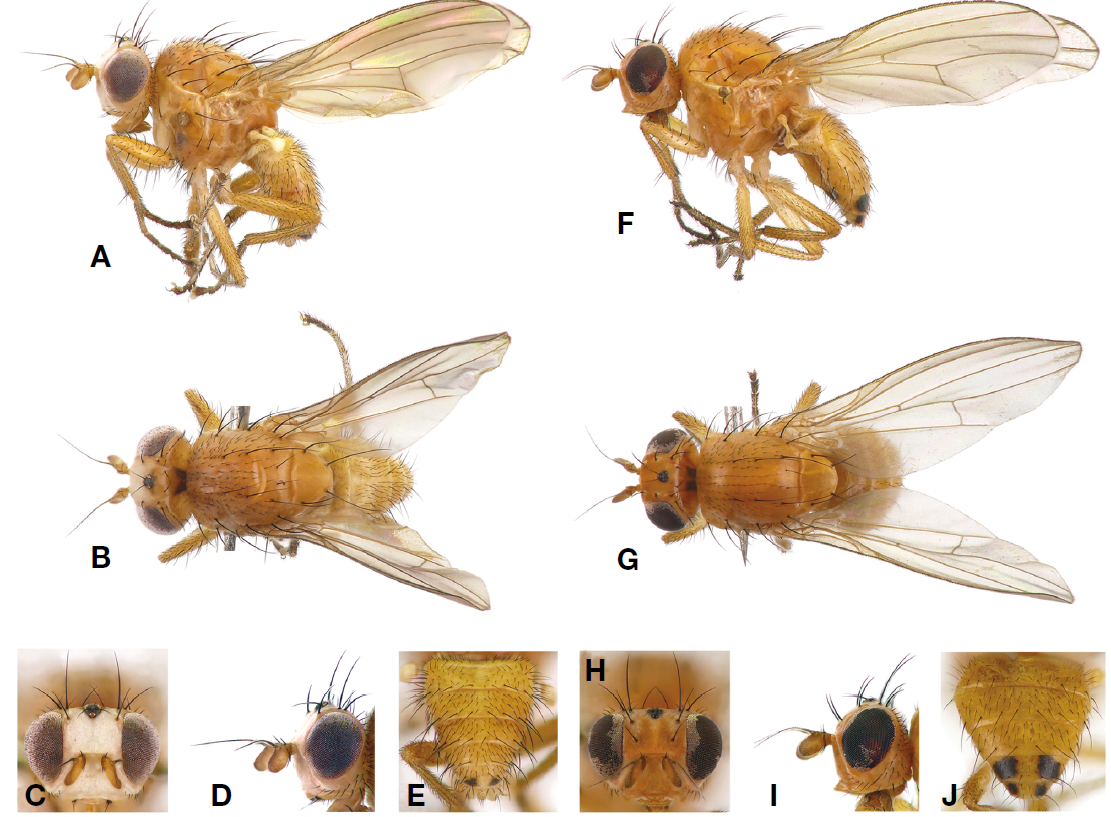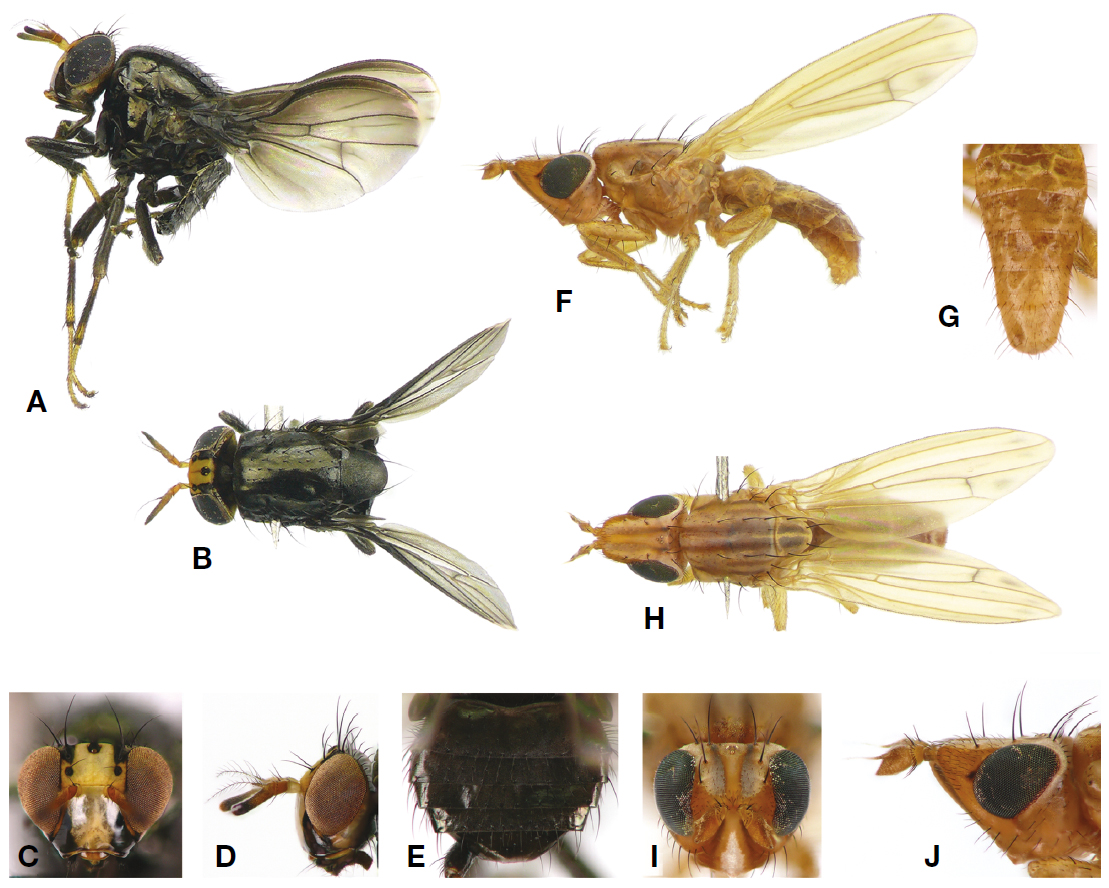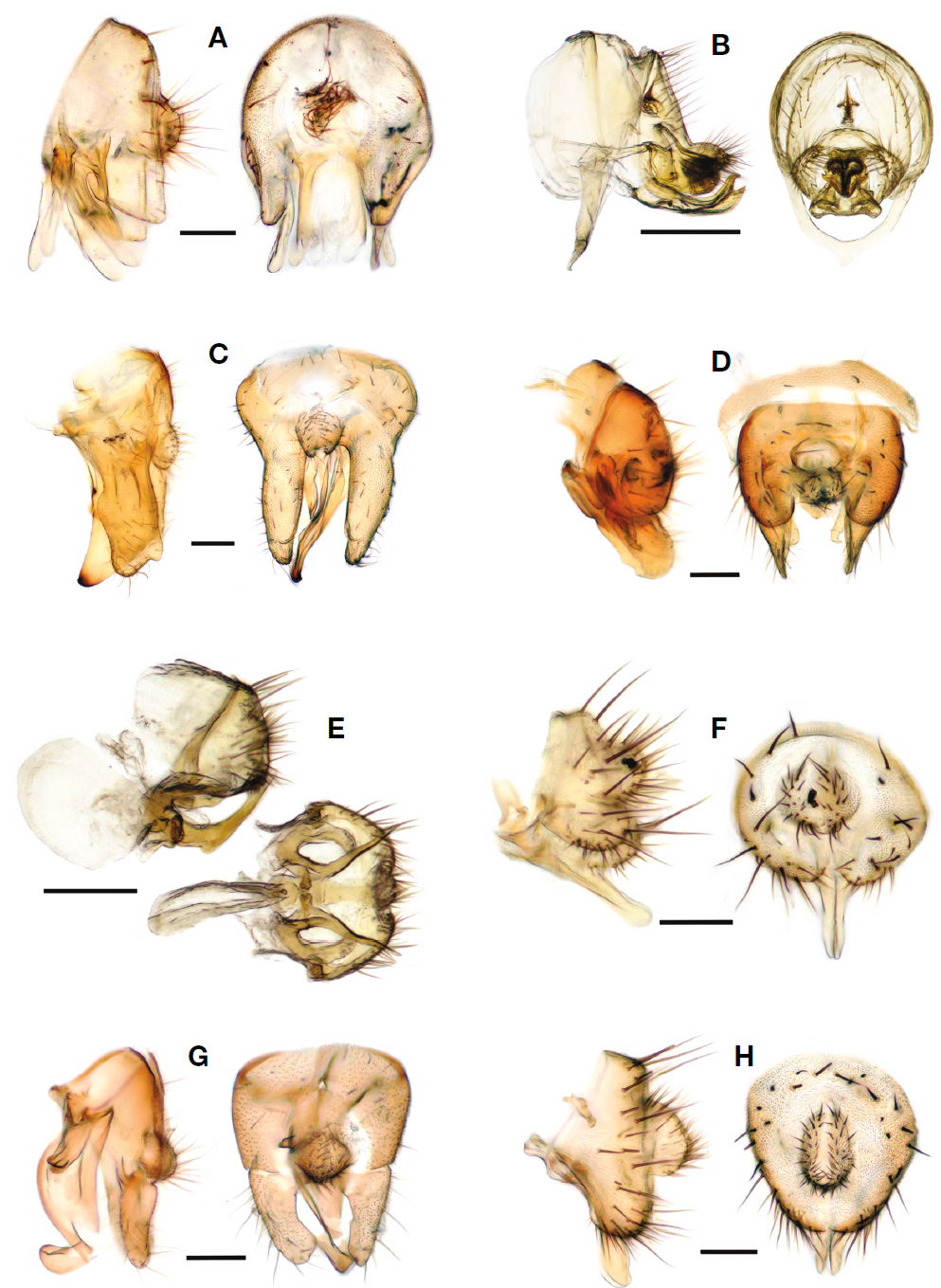



A total of 36 species and 11 genera of the fly family Lauxanidae have been previously recorded in Korean Peninsula. As a result of our ongoing study of this family, we here report the following nine species new to Korea: Homoneura albomarginata
The family Lauxaniidae is a large family of acalyptrate flies with about 1,838 described species worldwide as of September 2015 (The Diptera Site). Lauxaniid flies are usually found in moist shady undergrowth, grassland, all forest types, sand dunes, mangrove swamps and even on mountain summits (Kim, 1994). Saprophagous larval stages are found in leaf litter, decaying vegetation and similar habitats (Kim, 1994).
Taxonomic investigation of Korean members of the family Lauxaniidae was initiated by Papp (1984a), who reported eight
As a result of our ongoing study of Korean Lauxaniidae, we here report the following nine species new to Korea:
Terminology and morphological interpretations follow Merz and Haenni (2000). For photography, consecutive digital images in different focal planes (usually 20 or more shots per a specimen) were taken with digital cameras and the images were Z-stacked using Helicon Focus software (Helicon Soft, Ltd., Kharkov, Ukraine). Habitus photographs were taken with a Panasonic (Osaka, Japan) DMC FZ50 camera and a Raynox (Yoshida Inc., Tokyo, Japan) DCR-250 macro conversion lens. Genitalic photographs were taken with a Nikon (Tokyo, Japan) D90 camera mounted on an Olympus (Tokyo, Japan) CX41 compound microscope.
All the specimens used in this study are deposited in the Division of Biological Science and Technology, Yonsei University, Wonju Campus, Korea (YSUW). The abbreviations of the other institutions mentioned in the text are as follows: HUS, Entomological Institute, Faculty of Agriculture, Hokkaido University, Sapporo, Japan; ZISP, Zoological Institute of the Russian Academy of Sciences, St. Petersbourg, Russia; ZMUM, Zoological Museum of Moscow University, Moscow, Russia.
Order Diptera Linnaeus, 1758
Family Lauxaniidae Latreille, 1804
Genus
Material examined. Korea: Gyeongsangbuk-do: 1♂, Bonghwa-gun, Myeongho-myeon, Mt. Cheongnyangsan, 13 Jul 2007, Lee HS et al.; Gyeonggi-do: 1♀, Gapyeong-gun, Buk-myeon, Hwaak-ri, 3 Jul 2006, Choi DS et al.; Gangwon-do: 1♀, Hongcheon-gun, Nae-myeon, Changchon-ri, North valley of Mt. Gyebangsan, 5 Aug 2005, Han HY, Lee HS; 1♂, 1♀, ditto, 14 Aug 2005, Han HY et al.; 1♂, 7♀, ditto, 31 Aug 2006, Lee HS, Lim JS; 4♂, 10♀, ditto, 20 Aug 2007, Lee HS, Jung JM.
Diagnosis. Body (Fig. 1A, B) yellowish brown in ground color with yellowish brown pruinosity; wing greyish semi-transparent with dark brown pattern covering apical 1/5 of cell r1, most of cell r2+3 except apex and some portions of cells br, r4+5, and dm and m; all setae black; setulae mostly black except for tiny whitish setulae on eyes and golden setulae on labella; body length 3.4-4.1 mm and wing length 3.3-3.6 mm. This species can be distinguished from the congeners by the combination of the following characteristics (modified from Shatalkin, 2000): (1) frons yellowish brown with two weak brown longitudinal bands (Fig. 1C); (2) occiput with brownish upper half area and pale yellowish brown lower half area; (3) palpus yellowish brown with apical 1/3 dark brown; (4) arista dark brown with long setulae longer than width of flagellomere 1 (Fig. 1D); (5) scutum with four brown longitudinal vittae (Fig. 1B); and (6) wing with unique pattern as described above (Fig. 1B).
Distribution. Korea, Japan, Russian Far East.
Remarks. The specimens collected in South Korea agree well with original description by Czerny (1932) and wing figures by Sasakawa and Ikeuchi (1982) and Shatalkin (2000).
Genus
Material examined. Korea: Gangwon-do: 1♂, Hongcheon-gun, Nae-myeon, Changchon-ri, North valley of Mt. Gyebangsan, 23 Jun 2005, Lee HS; 4♀, Hongcheon-gun, Nae-myeon, Mt. Gachilbong from Sambongyaksu, 17 Jun 2005, Choi DS et al.; 6♂, 2♀, ditto, 26 Aug 2005, Lee HS, Suk SW; 2♂, 6♀, ditto, 16 Jun 2007, Lee HS, Lim JS; 2♂, ditto, 7 Jul 2007, Lee HS, Lee YB; 2♂, ditto, 7 Sep 2008, Lee HS et al.; 1♂, 2♀, Pyeongchang-gun, Jinbu-myeon, Mt. Odaesan from Bukdaesa Temple to ticket office, 17 Jun 2006, Lee HS, Lee YR.
Diagnosis. Body (Fig. 1E, F) yellowish brown in ground color with yellowish brown pruinosity; wing semitransparent with yellowish brown tinge; setae black; setulae mostly black except for tiny whitish setulae on eyes and golden setulae on labella; body length 3.78-4.50 mm; wing length 4.3-4.85 mm. This species can be distinguished from the congeners by the combination of the following characteristics (modified from Shatalkin, 2000): (1) body entirely yellowish brown (Fig. 1E, F); (2) arista with short setulae as long as thickness of aristal base (Fig. 1H); (3) scutum with 0+1 acrostichal and 0+3 dorsocentral setae (Fig. 1F); and (4) presutural scutum with 6 rows of short acrostichal setulae (Fig. 1F).
Distribution. Korea, Russian Far East, West Europe.
Remarks. The specimens collected in South Korea agree well with male genitalic figures by Remm and Elberg (1979) and Shatalkin (2000).
Genus
Material examined. Korea: Chungcheongbuk-do: 2♂, 2♀, Jecheon-si, Songhak-myeon, 9 Jun 2007, Han HY et al.; Gangwon-do: 1♂, Jeongseon-gun, Nam-myeon, Mt. Mindungsan from Yupyeong-ri to 1,119 m peak, 10 Jun 2007, Han HY et al.; 2♂, Wonju-si, Heungeop-myeon, Maeji-ri, Yonsei Univ. Campus, 15 Jun 2005, Byun HW, Lee HS; 1♀, ditto, 14 Jul 2005, Lee HS; 1♂, ditto, 10 Apr 2007, Lim JS; 1♀, ditto, 14 Apr 2007, Lim JS; 1♀, ditto, 15 Apr 2007, Lim JS; 1♂, ditto, 11 Aug 2007, Lee HS et al.
Diagnosis. Body (Fig. 2A, B) yellowish brown in ground color with some brown to dark brown areas, with yellowish brown to gray pruinosity; wing semitransparent with yellowish brown tinge, with more brownish areas along costal margin; all setae black; setulae mostly black except for tiny whitish setulae on arista and eyes and golden setulae on labella; body length 3.05-4.30 mm and wing length 3.10-3.65 mm. This species can be distinguished from the congeners by the combination of the following characteristics (modified from Shatalkin, 2000): (1) flagellomere 1 about 9 times longer than pedicel length (Fig. 2C); (2) arista whitish except for basal 1/5 yellowish brown, with short whitish setulae (Fig. 2C); (3) postsutural scutum anteriorly with 4 rows of short acrostichal setulae, posteriorly with 2 rows of short acrostichal setulae (Fig. 2B); (4) hind trochanter ventrally with small dark brown protrusion (only in male); and (5) haltere with stem yellowish brown and knob brownish.
Distribution. Korea, Japan.
Remarks. The specimens collected in South Korea agree well with the original description by Shatalkin (1998b).
Genus
Material examined. Korea: Gangwon-do: 2♀, Donghae-si, Samhwa-dong, Mureung valley, 19 May 2009, Lee HS, Suk SW; 1♂, Jeongseon-gun, Jeongseon-eup, Mt. Gariwangsan, 7 Jun 2011, Lee HS et al.; 1♂, Wonju-si, Heungeop-myeon, Maeji-ri, Yonsei Univ. Campus, 21 May 2010, Lee HS.
Diagnosis. Body (Fig. 2D, E) yellowish brown to dark brown in ground color with some greyish brown areas, with greyish brown pruinosity; wing semitransparent with pale yellowish brown tinge; all setae black; setulae mostly black except for tiny whitish setulae on eyes and golden setulae on labella; body length 3.15-3.50 mm and wing length 3.35-3.80 mm. This species can be distinguished from the congeners by the combination of the following characteristics (modified from Shatalkin, 2000): (1) face dark brown (Fig. 2F); (2) gena with dark brown spots; (3) scutum greyish brown with 6 rows of short acrostichal setulae (Fig. 2E); (4) presutural scutum with two dark brown median longitudinal vittae and lateral dark brown area (Fig. 2E); and (5) abdominal tergites 3-6 dark brown with diffused yellowish brown median vitta (Fig. 2G).
Distribution. Korea, Russian Far East.
Remarks. The specimens collected in South Korea agree well with the original description by Shatalkin (2000).
Genus
Material examined. We have examined over 270 Korean specimens collected between March and October with highest peak in June: Gangwon-do: 130♂, 146♀; Gyeongsangbuk-do: 1♀; Gyeongsangnam-do: 1♂.
Diagnosis. Body (Fig. 3A, B) yellowish brown in ground color with with some dark brown areas, with yellowish brown to greyish brown pruinosity; wing semitransparent with pale yellowish brown tinge; all setae black; setulae mostly black except for tiny whitish setulae on eyes and golden setulae on labella; body length 3.30-4.43 mm and wing length 4.1-4.55 mm. This species can be distinguished from the congeners by the combination of the following characteristics (modified from Shatalkin, 2000): (1) head more or less rectangular shape in lateral view (Fig. 3D); (2) face with five dark brown round spots at fronto-dorbital plates next to antenna, upper corner of face between antennae, and lateral corners of midface (Fig. 3C); (3) flagellomere 1 entirely yellowish brown (Fig. 3D); (4) arista with setulae short, weakly developed (Fig. 3D); and (5) haltere entirely yellowish brown (Fig. 3A).
Distribution. Korea, Japan, Russian Far East.
Remarks. The specimens collected in South Korea agree well with the original description by Shatalkin (1992).
Genus
Material examined. Korea: Gyeongsangnam-do: 1♀, Geochang-gun, Buksang-myeon, Mt. Deogyusan, 3 May 2008, Lee HS et al.; Gangwon-do: 1♀, Jeongseon-gun, Jeongseon-eup, Mt. Gariwangsan, 17 Jun 2007, Lee HS et al.
Diagnosis. Body (Fig. 3F, G) yellowish brown in ground color with some yellowish brown to dark brown areas, with greyish brown pruinosity; wing semitransparent with pale yellowish brown tinge, with more brownish area in cell sc; all setae black; setulae mostly black except for tiny whitish setulae on eyes and golden setulae on labella; body length 3.10-3.15 mm and wing length 3.25-3.38 mm. This species can be identified by the combination of the following characteristics (modified from Shatalkin, 2000): (1) thorax gray with two dark brown longitudinal vittae (Fig. 3G); (2) abdomen dark brown with pairs of yellowish brown lateral spots at anterior margins of tergites 3-6 (Fig. 3J); and (3) all tibiae yellowish brown with pair of black rings (Fig. 3F).
Distribution. Korea, Japan, Russian Far East.
Remarks. The specimens collected in South Korea agree well with the original description by Shatalkin (1992).
Genus
Material examined. Korea: Gangwon-do: 1♂, Hoengseong-gun, Dunnae-myeon, Mt. Cheongtaesan Sapgyo-ri to 1,200 m peak, 6 Jul 2006, Choi DS et al.; 2♀, Hongcheon-gun, Nae-myeon, Changchon-ri, North valley of Mt. Gyebangsan, 22 Jul 2005, Lee HS; 1♂, 2♀, Hongcheon-gun, Nae-myeon, Mt. Gachilbong from Sambongyaksu, 16 Jun 2007, Lee HS, Lim JS; 3♂, 1♀, Jeongseon-gun, Nam-myeon, Mt. Mindungsan from Yupyeong-ri to 1,119 m peak, 20 Jun 2005, Han HY et al.; 1♂, 5♀, ditto, 24 Jun 2005, Han HY et al.; 1♀, Wonju-si, Heungeop-myeon, Maeji-ri, Yonsei Univ. Campus, 26 May 2005, Lee HS; 1♂, ditto, 15 Jun 2005, Byun HW, Lee HS; 1♀, Wonju-si, Panbu-myeon, Segok-ri, Mt. Baegunsan from Yongsu-gol to 1,087.1 m peak, 5 Jun 2005, Han HY, Lee HS; 4♂, 2♀, ditto, 14 Jun 2005, Han HY et al.; 2♂, 3♀, ditto, 21 Jun 2005, Merz B.
Diagnosis. Body (Fig. 4A, B, F, G) yellowish brown in ground color with some whitish yellow to dark brown areas, with yellowish brown to greyish brown pruinosity; wing semitransparent with pale yellowish brown tinge; all setae black; setulae mostly black except for tiny whitish setulae on eyes and golden setulae on labella; body length 2.8-4.13 mm and wing length 2.95-3.83 mm. This species can be distinguished from the congeners by the combination of the following characteristics (modified from Shatalkin, 2000): (1) male with frons, parafacialia, and face whitish yellow (Fig. 4C, D), contrasting with plain yellow brown coloration in female (Fig. 4F, G); (2) frons with anterior fronto-orbital seta in female (Fig. 4H) but without in male (Fig. 4C); and (3) abdominal tergites 5-6 with pairs of dark brown median spots and lateral spots only in female (Fig. 4J).
Distribution. Palaearctic.
Remarks. The specimens collected in South Korea agree well with the redescription by Collin (1947), the taxonomic notes by Merz (2003), and the male genitalic figures by Remm and Elberg (1979).
Genus
Material examined. Korea: Jeju-do: 1♀, Jeju-si, Haean-dong, 18 Sep 2010, Lee HS et al.; 1♀, Seogwipo-si, Seohong-dong, 24 Aug 2010, Lee HS et al.; 2♂, ditto, 16 Sep 2010, Lee HS et al.
Diagnosis. Body (Fig. 5A, B) yellowish brown to dark brown in ground color with yellowish brown pruinosity; wing semitransparent with dark brown tinge, with darker areas along costal margin except for whitish areas in apices of cells r2+3 and r4+5; all setae black; setulae mostly black except for tiny whitish setulae on eyes and golden setulae on labella; body length 2.95-2.98 mm and wing length 2.58-2.78 mm. This species can be distinguished from the congeners by the combination of the following characteristics (modified from Shatalkin, 2000): (1) palpus entirely dark brown; (2) antennal scape about as long as pedicel length (Fig. 5D); (3) flagellomere 1 yellowish brown with apical 1/3 dark brown, about 6 times longer than pedicel length (Fig. 5D); (4) arista with long setulae, setulae about 2 times as long as width of flagellomere (Fig. 5D); (5) thorax entirely black (Fig. 5B); (6) scutum with 4 rows of acrostichal setulae (Fig. 5B); (7) fore tibia largely black, with basal yellowish brown area; and (8) mid and hind tarsomere 5 dark brown (Fig. 5A).
Distribution. Korea, Japan.
Remarks. The specimens collected in South Korea agree well with the original description by Shatalkin (1998a).
Genus
Material examined. Korea: Jeju-do: 1♂, Jeju-si, grasslands in and around Jeolmul recreation forest, 26 Aug 2003, Han HY et al.; 1♂, Namjeju-gun, Pyoseon-myeon, near 1118 road Namjoro swimteo, 19 Oct 2005, Han HY et al.; 56♂, 32♀, Seogwipo-si, Seohong-dong, 24 Aug 2010, Lee HS et al.; 4♂, 6♀, ditto, 16 Sep 2010, Lee HS et al.
Diagnosis. Body (Fig. 6F, H) yellowish brown in ground color with some brown areas, with yellowish brown pruinosity; wing semitransparent with pale yellowish brown tinge; all setae black; setulae mostly black except for tiny whitish setulae on eyes and golden setulae on labella; body length 3.38-4.23 mm and wing length 3.35-3.65 mm. This species can be distinguished from the congeners by the combination of the following characteristics (modified from Shatalkin, 2000): (1) ocellar triangle yellowish brown with weak ocellar setae; (2) frons with two brown longitudinal vittae (Fig. 5I); (3) arista whitish except for basal 1/5 yellowish brown; (4) parafacialia with single dark brown spot anterior to eye margin (Fig. 5J); (5) face with whitish longitudinal stripe (Fig. 5I); (6) vein r-m and dm-cu without any spots (Fig. 5F, H); and (7) abdomen yellowish brown without dark spots or bands (Fig. 5G).
Distribution. Korea, China, Russian Far East.
Remarks. The specimens collected in South Korea agree well with the original description by Shatalkin (1997).

